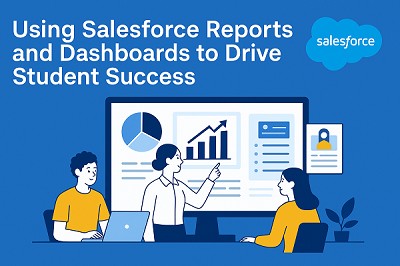


Use Salesforce reports and dashboards to improve student success with real-time insights and proactive support.
Student success is at the heart of every educational institution’s mission. But ensuring success isn’t just about offering great programs—it’s about understanding each student’s journey and acting on that insight in real-time. That’s where Salesforce Reports and Dashboards come into play.
With the right setup, educational institutions can leverage Salesforce to track, analyze, and optimize student engagement, academic performance, support services, and more. The result? Better outcomes, improved retention, and data-driven strategies that work.
When student data is scattered across multiple systems or stuck in spreadsheets, it’s nearly impossible to get a clear view of how a student is doing. Faculty and advisors may miss early warning signs. Administrative staff might overlook engagement trends. And leadership teams lack the insights needed to make informed decisions.
Salesforce fixes this. It unifies student data and presents it in real-time dashboards and reports, giving every stakeholder the information they need to support success proactively.
With Education Cloud, you can build dashboards for:
GPA trends and grade distribution
Course completion rates
Attendance monitoring
Credit hours by semester
Number of advising sessions attended
Participation in events and programs
Student support case resolution times
Communication open/click rates (email or portal activity)
Drop in grades or attendance
Missed deadlines or appointments
Low engagement signals
Risk scoring based on custom logic
Number of students advised per month
Time to resolve academic concerns
Survey feedback from advisees
Enrollment trends
Retention and attrition rates
Resource utilization by the program
Budget tracking and ROI of student programs
Here’s how different roles within an institution benefit from real-time dashboards:
Advisors get alerts when students show signs of academic or social disengagement.
Faculty can spot struggling students and refer them to support services.
Career services can track employment outcomes and workshop participation.
Leadership gains a top-down view of key KPIs, like retention and student satisfaction.
These insights allow staff to respond faster, make better choices, and personalize support—resulting in a stronger student experience.
Salesforce dashboards update dynamically, so you’re always working with the latest information.
Drill down into data by program, advisor, risk level, or cohort year—perfect for tailored interventions.
Choose from bar charts, gauges, heatmaps, funnel reports, and more—designed to make your insights intuitive and actionable.
Set up automated notifications when specific thresholds are met (e.g., a student’s GPA drops below 2.5).
Monitor trends over time to measure the impact of student success initiatives and make strategic improvements.
Imagine a dashboard that flags students who missed two advising appointments, have a GPA below 2.7, and haven’t logged into the student portal in a week. That’s a clear signal for an advisor to intervene.
With Salesforce, that alert can be automatically generated, assigned to the right advisor, and followed up with a personalized message—without anyone digging through spreadsheets or manually compiling reports.
That’s the power of real-time, actionable data.
Define KPIs Before Building Dashboards
Start with your goals—what does “student success” mean for your institution?
Standardize Data Entry and Sources
Dashboards are only as good as the data they’re built on. Ensure consistency across teams.
Train Staff to Use Dashboards Effectively
Provide basic training so advisors, faculty, and leadership can interpret data accurately and use it daily.
Automate Where Possible
Use scheduled reports and alert triggers to stay ahead of issues before they escalate.
Iterate and Improve
Continuously optimize your reports and dashboards based on user feedback and evolving goals.
To truly unlock the value of reports and dashboards in Salesforce, institutions should:
Align their data model with Education Cloud’s Education Data Architecture (EDA)
Define clear goals for tracking and measuring student success
Partner with a Salesforce consultant who understands both education and CRM customization
Student success isn’t just about academic performance—it’s about knowing where students stand, how they’re engaging, and how best to support them throughout their journey. Salesforce Reports and Dashboards make this not only possible but powerful.
Whether you’re a university, K–12 school, or workforce development program, leveraging Salesforce data visualization tools can drive better decisions, faster action, and real impact.
Connect with a Salesforce Education Cloud Consultant to build meaningful dashboards, align your team, and support every student’s success with confidence.
